MERCEDES-BENZ C-Class COUPE 2017 CL205 Owner's Manual
Manufacturer: MERCEDES-BENZ, Model Year: 2017, Model line: C-Class COUPE, Model: MERCEDES-BENZ C-Class COUPE 2017 CL205Pages: 354, PDF Size: 8.66 MB
Page 331 of 354

Vehicleidentificatio nplate
Even if yo uhavec alculate dthe totalc argo care-
fully ,you shoul dstillm ake sure thatt he gross
vehicl eweigh trating and the gross axl eweigh t
rating are not exceeded .Detail scan be found on
the vehicl eide ntificatio nplate on the B-pillar on
the driver' ssideoft he vehicl e(
Ypage 326).
Permissibl eGrossVehicl eWeight Rating
(GVWR): the gross weight of the vehicle, al lpas -
sengers ,loa da nd traile rload/n oseweight (if
applicable) must not exceed the permissible
gross vehicl eweigh t.
Gros sAxleW eight Ratin g(GAWR): the maxi-
mump ermissibl eweigh tthatc an be carrie dby
one axl e(front or rea raxle).
To ensure thaty ourvehicl edoesn ot exceed the
maximu mpermissibl evalue s(gros sv ehicle
weight and maximu mgross axl eweigh trating),
have your loaded vehicl e(including driver, occu-
pants, cargo, and ful ltraile rloa difa pplicable)
weighed on asuitabl evehicl eweigh bridge.
Alla bout wheels and tires
Uniform Tire Quality Grading Stand-
ards
Overvie wofTire Quality Grading Stand-
ards
Uniform Tire Quality Grading Standard sare U.S.
government specifications. Their purpose is to
provid edrivers with uniform reliabl einformation
on tire performanc edata. Tire manufacturers
have to grade tire susing thre eperformanc efac-
tors: :trea dwearg rade, ;tractio ngrade and
= temperature grade .These regulations do not
appl ytoC anada. Nevertheless ,alltire ssoldi n
North America are provided with the corre- sponding quality grading marking
sonthe side-
wall of the tire.
Quality grade scan be found, where applicable,
on the tire sidewall between trea dshoulde rand
maximu msection width.
Example:
RTreadwear grade: 200
RTraction grade:AA
RTemperature grade: A
All passenger car tire smustc onform to the stat-
utory safety requirements in additio ntothese
grades.
iThe actual value sfor tire sare vehicle-spe-
cifi cand mayd eviate from the value sinthe
illustration.
Treadwear
The treadwea rgrade is acomparative rating
based on the wear rate of the tire when tested
under controlled conditions on aspecified U.S.
government course.F or example,atire graded
150 woul dwearo ne and one-hal ftime sasw ell
on the government test trac kasat ire graded
100.
The relative performance of tire sdepen ds upon
the actual conditions of thei ruse,h owever, and
mayd epartsignificantly from the norm du eto
variations in driving habits, service practices
and difference sinroadc haracteristic sand cli-
mate.
Traction
GWARNING
The tractio ngrade assigned to thist ire is
based on straight-ahea dbraking traction
tests ,and does not includ eacceleration, cor-
nering, hydroplaning, or peak tractio nchar-
acteristics.
!Avoi dwheelspin.T hisc an lead to damage to
the drive train.
The tractio ngrade s–from highest to lowest –
are AA, A, Band C. Those grade srepresent the
tire's ability to stop on we tpavement as meas-
ured under controlled conditions on specified
government test surfaces of asphalt and con-
crete .Atire marked Cmayhave poor traction
performance.
Al la bout wheels and tires329
Wheel sand tires
Z
Page 332 of 354
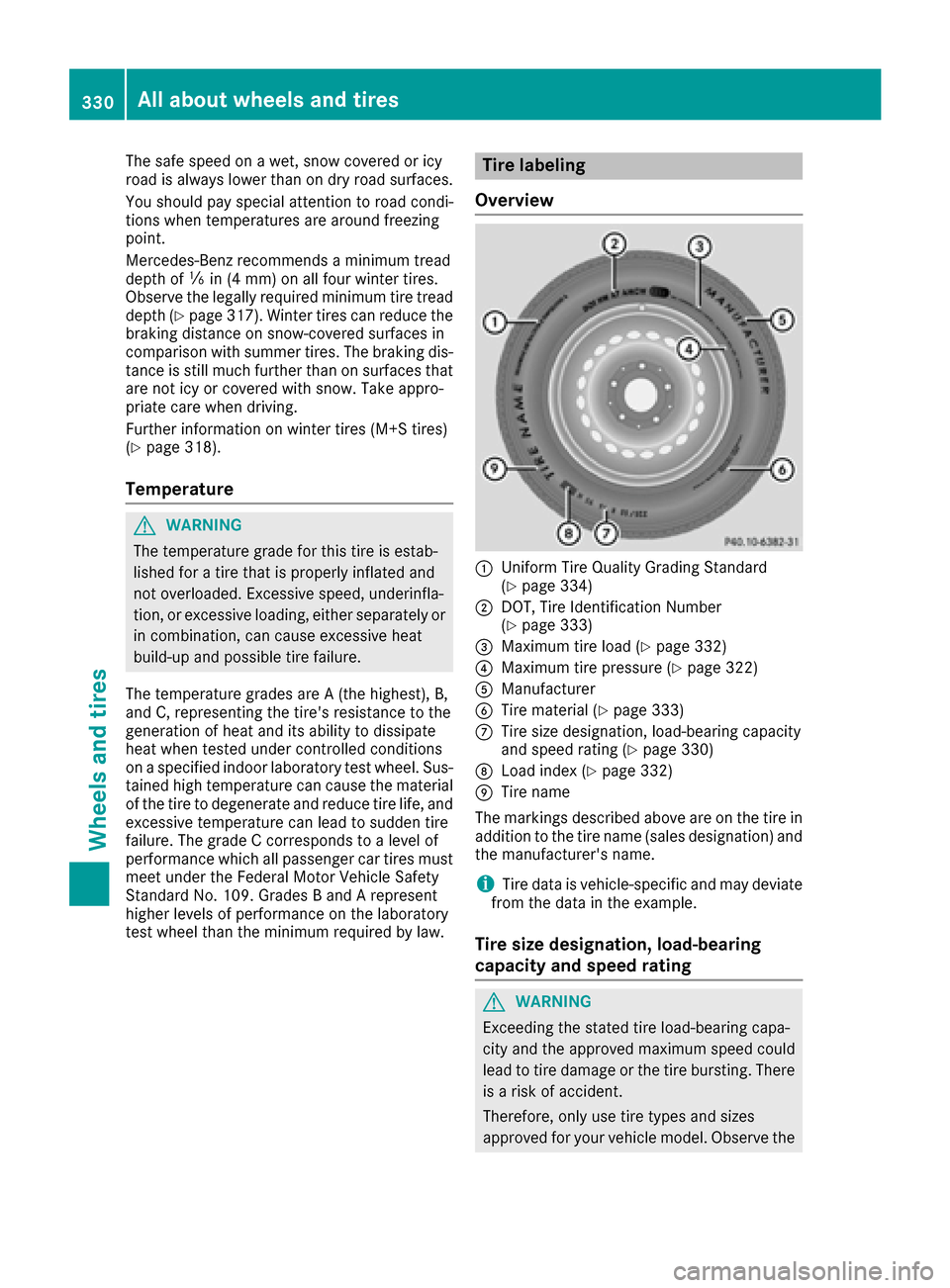
The safe speed onawet, snow covered or icy
road is alwaysl ower than on dry road surfaces.
You should pay special attention to road condi-
tions when temperatures are around freezing
point.
Mercedes-Benz recommends aminimum tread
depth of ãin (4 mm) on all four winter tires.
Observe the legally required minimum tire tread
depth (
Ypage 317). Winter tires can reduce the
braking distance on snow-covered surfaces in
comparison with summer tires. The braking dis-
tanc eiss till much further than on surfaces that
are not icy or covered with snow. Take appro-
priate care when driving.
Further information on winter tires (M+S tires)
(
Ypage 318).
Temperature
GWARNING
The temperature grade for this tire is estab-
lished for atire that is properly inflated and
not overloaded. Excessive speed, underinfla-
tion, or excessivel oading, either separately or
in combination, can cause excessiveh eat
build-up and possible tire failure.
The temperature grades are A(the highest), B,
and C, representing the tire's resistanc etothe
generation of heat and its ability to dissipate
heat when tested under controlled conditions
on aspecified indoor laboratory test wheel. Sus-
tained high temperature can cause the material
of the tire to degenerate and reduce tire life, and
excessivet emperature can lead to sudden tire
failure. The grade Ccorresponds to alevel of
performance which all passenger car tires must
meet under the Federal Motor Vehicle Safety
Standard No. 109. Grades BandArepresent
higher levels of performance on the laboratory
test wheel than the minimum required by law.
Tire labeling
Overview
:Uniform Tire Quality Grading Standard
(Ypage 334)
;DOT, Tire Identification Number
(Ypage 333)
=Maximum tire load (Ypage 332)
?Maximum tire pressure (Ypage 322)
AManufacturer
BTire material (Ypage 333)
CTire size designation, load-bearing capacity
and speed rating (Ypage 330)
DLoad index (Ypage 332)
ETire name
The markings described above are on the tire in
addition to the tire name (sales designation) and
the manufacturer's name.
iTire data is vehicle-specific and may deviate
from the data in the example.
Tire size designation, load-bearing
capacity and speed rating
GWARNING
Exceeding the stated tire load-bearing capa-
city and the approved maximum speed could
lead to tire damage or the tire bursting. There is ar isk of accident.
Therefore, only use tire types and sizes
approved for your vehicle model. Observe the
330All about wheelsa nd tires
Wheels and tires
Page 333 of 354
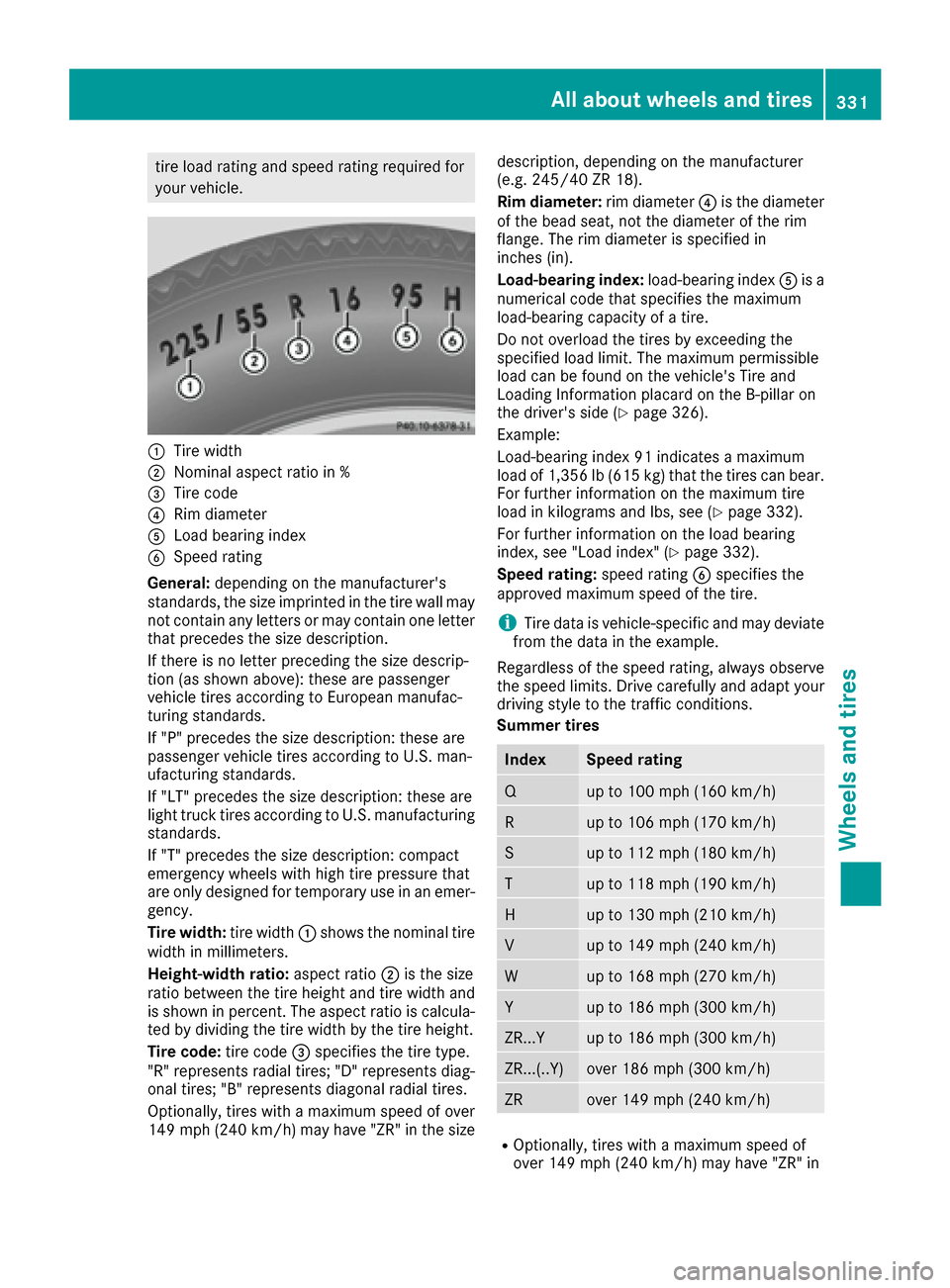
tire load rating and speedrating required for
your vehicle.
:Tire width
;Nomina laspec tratio in %
=Tire code
?Rimd iame ter
ALoadbeari ng index
BSpeed rating
General: depending on the manufacturer's
standards ,the size imprinted in the tire wall may
not contain any letters or mayc ontain one letter
thatp recedes the size description.
If there is no letter preceding the size descrip-
tio n(as shown above): these ar epassenger
vehicl etiresa ccording to Europea nmanufac-
turing standards.
If "P "precedes the size description: these are
passenge rvehicl etiresa ccording to U.S. man-
ufacturin gstandards.
If "LT" precedes the size description: these are
light truck tire saccording to U.S. manufacturing
standards.
If "T "precedes the size description: compact
emergency wheels with high tire pressure that
ar eo nlyd esig nedf or temporary us einanemer-
gency.
Tire width: tire width:shows the nominal tire
width in millimeters.
Height-width ratio: aspect ratio;is the size
ratio between the tire height and tire width and
is shown in percent. The aspect ratio is calcula-
ted by dividing the tire width by the tire height.
Tire code: tire code=specifie sthe tire type.
"R "r epresents radial tires; "D" represents diag-
ona ltires
; "B" represents diagona
lradial tires.
Optionally ,tire sw itham aximum spee dofover
149 mph (24 0km/h )mayhave "ZR" in the size description, depending on the manufacturer
(e.g. 245/40Z
R18).
Rim diameter: rim diameter?is the diameter
of the bead seat, not the diamete rofthe rim
flange .The ri mdiame teriss pecifie din
inches (in).
Load-bearin gind ex: load-bearing index Ais a
numerical cod ethats pecifie sthe maximum
load-bearing capacity of atire.
Do not overload the tire sbyexceeding the
specifie dloa dlimit .The maximu mpermissible
load can be found on the vehicle's Tire and
Loading Informatio nplacard on the B-pillar on
the driver's side (
Ypage 326).
Example:
Load-bearin gindex 91 indicates amaximum
load of 1,356 lb (61 5kg)thatt he tire scan bear.
For furthe rinformation on the maximum tire
load in kilograms and lbs, see(
Ypage 332).
For furthe rinformation on the load bearing
index, see" Loadindex" (
Ypage 332).
Speed rating: speedrating Bspecifie sthe
approved maximum spee dofthe tire.
iTire data is vehicle-specific and mayd eviate
fromt he data in the example.
Regardles softhe spee drating ,alway sobser ve
th
e spee dlimit s. Drive carefull yand adap tyou r
drivin gstyle to the trafficc onditions.
Summe rtires
IndexSpeed rating
Qup to 100 mph (16 0km/h)
Rup to 106 mph (17 0km/h)
Sup to 112 mph (18 0km/h)
Tup to 118 mph (19 0km/h)
Hup to 130 mph (21 0km/h)
Vup to 149 mph (24 0km/h)
Wup to 168 mph (27 0km/h)
Yup to 186 mph (30 0km/h)
ZR...Yup to 186 mph (30 0km/h)
ZR...(..Y)ove r186 mph (300 km/h)
ZRove r149 mph (240 km/h)
ROptionally ,tire sw itham aximum spee dof
ove r149 mph (24 0km/h )mayhave "ZR" in
Alla bout wheels an dtires331
Wheel sand tires
Z
Page 334 of 354
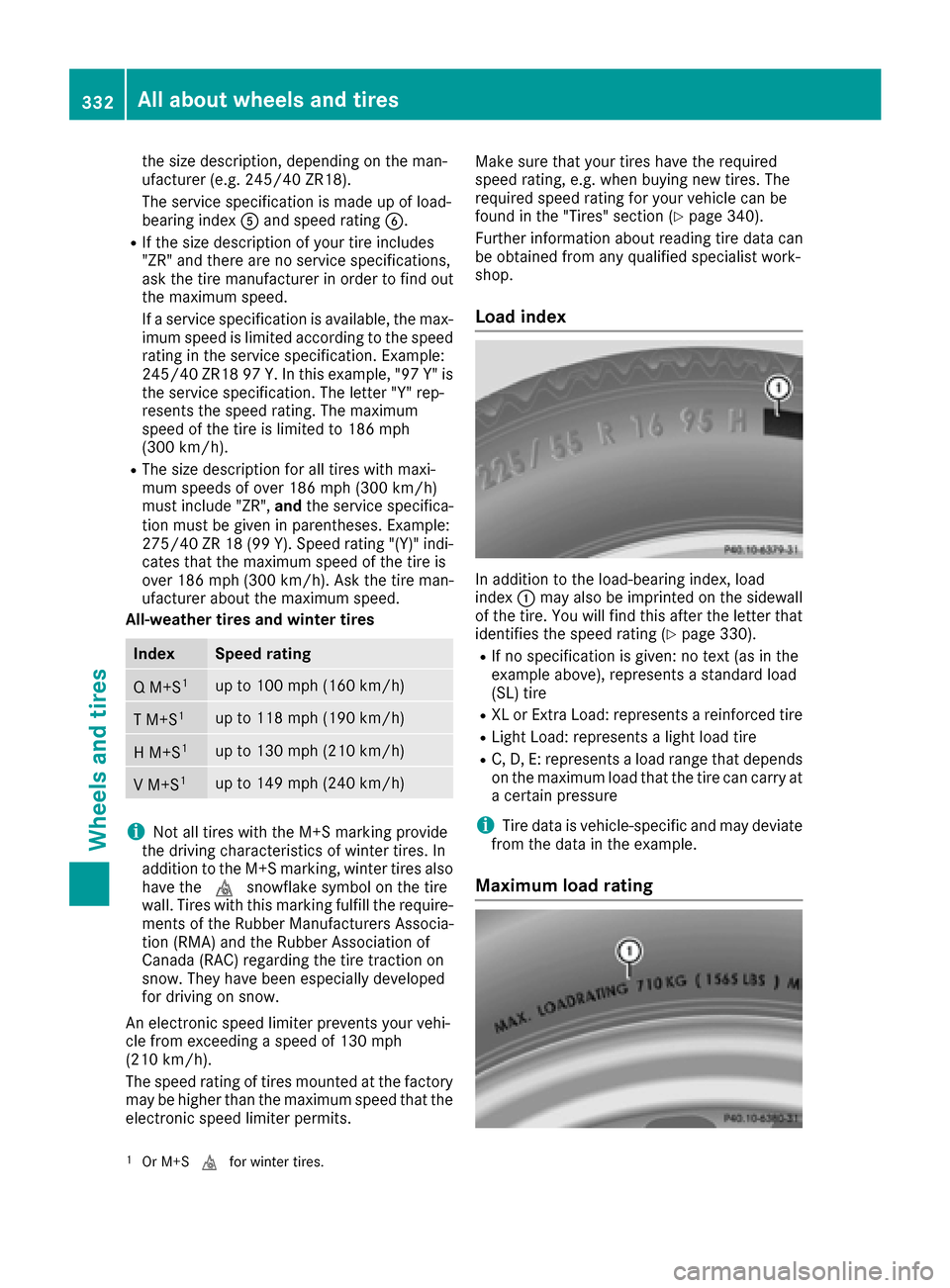
the size description, depending on the man-
ufacturer (e.g. 245/40ZR18).
The service specification is made up of load-
bearing index Aand spee drating B.
RIf the size description of your tire includes
"ZR" and there ar enoservice specifications,
as kt he tire manufacturer in order to fin dout
the maximum speed.
If as ervice specification is available, the max-
imum spee dislimited according to the speed
rating in the service specification. Example:
245/40Z R1897Y.Int his example ,"97 Y" is
the service specification. The letter "Y" rep-
resents the speed rating. The maximum
speed of the tire is limited to 186 mph
(300 km/h).
RThe size descriptionf or all tires with maxi-
mum speedsofo ver 186 mph (300 km/h)
must include "ZR", andthe service specifica-
tion must be given in parentheses .Example:
275/40 ZR 18 (99 Y) .Speed rating "(Y)" indi-
cates that the maximum speed of the tire is
over 186 mph (300 km/h). Ask the tire man-
ufacturer abou tthe maximum speed.
All-weather tires and winter tires
IndexSpeed rating
QM +S1up to 100 mph (160 km/h)
TM+S1up to 118 mph (190 km/h)
HM +S1up to 130 mph (210 km/h)
VM+S1up to 149 mph (240 km/h)
iNot all tires with the M+S marking provide
the driving characteristics of winter tires. In
addition to the M+S marking, winter tires also
have the isnowflake symbo lonthe tire
wall. Tires with this marking fulfill the require-
ments of the Rubber Manufacturers Associa-
tion (RMA) and the Rubber Association of
Canada (RAC) regarding the tire traction on
snow. They have been especially developed
for driving on snow.
An electronic speed limiter prevents you rvehi-
cle from exceeding aspeed of 130 mph
(210 km/h).
The speed rating of tires mounted at the factory
may be higher than the maximum speed that the
electronic speed limiter permits. Make sure that you
rtires have the required
speed rating, e.g. when buying new tires. The
required speed rating for you rvehicle can be
found in the "Tires" section (
Ypage 340).
Further information abou treading tire data can
be obtained from any qualifieds pecialist work-
shop.
Load index
In addition to the load-bearing index, load
index :may also be imprinted on the sidewall
of the tire. You wil lfind this after the letter that
identifiest he speed rating (
Ypage 330).
RIf no specification is given: no text (as in the
example above), represents astandard load
(SL) tire
RXL or ExtraL oad: represents areinforced tire
RLight Load: represents alightl oad tire
RC, D, E: represents aload range that depends
on the maximum load that the tire can carry at
ac ertain pressure
iTire data is vehicle-specific and may deviate
from the data in the example.
Maximum load rating
1Or M+S ifor winter tires.
332Allabout wheels and tires
Wheelsa nd tires
Page 335 of 354
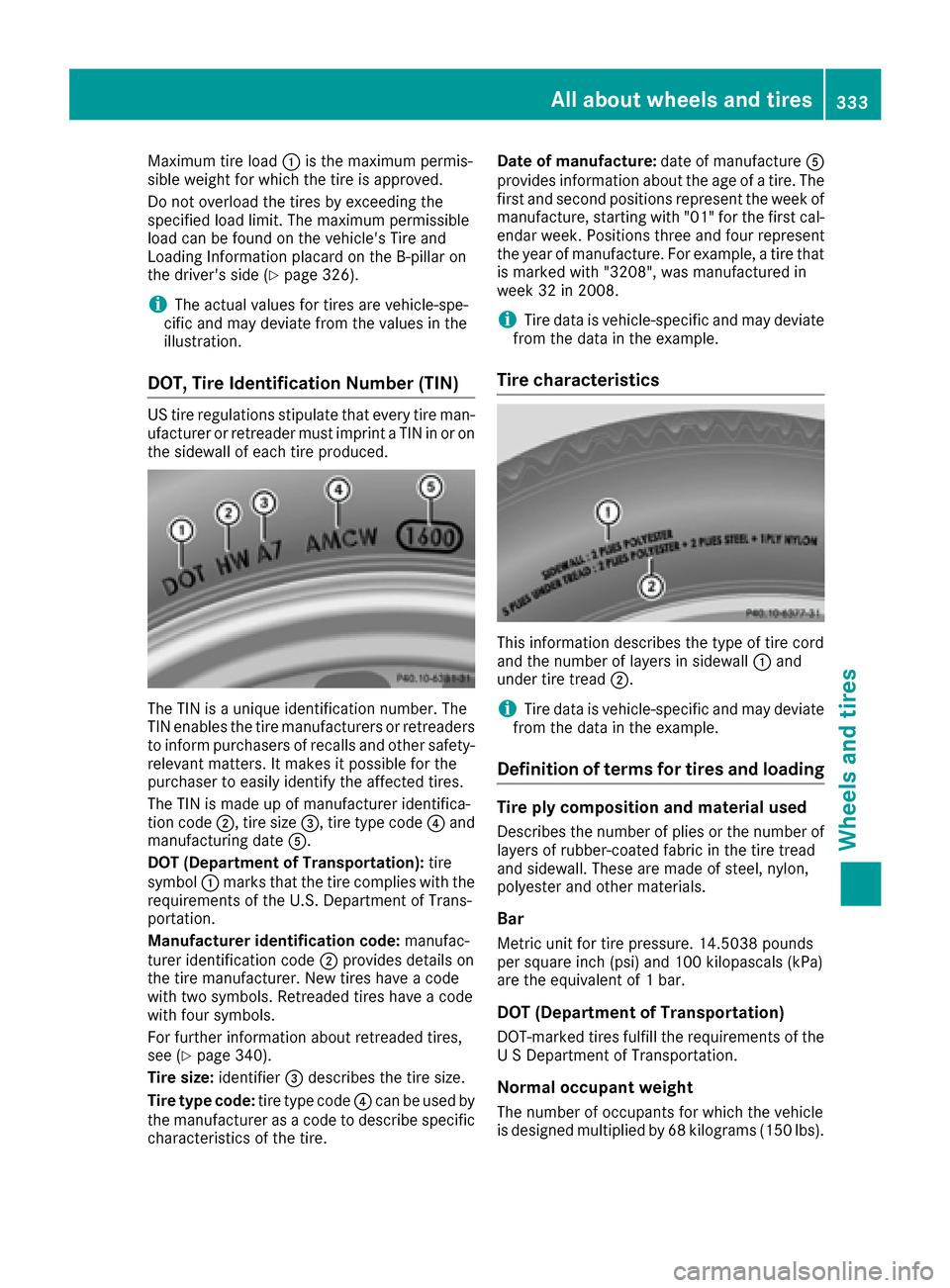
Maximum tire load:is the maximum permis-
sible weight for which the tire is approved.
Do not overload the tires by exceeding the
specified load limit. The maximum permissible
load can be found on the vehicle's Tire and
Loading Information placard on the B-pillar on
the driver's side (
Ypage 326).
iThe actual values for tires are vehicle-spe-
cific and may deviate from the values in the
illustration.
DOT, Tire Identification Number (TIN)
US tire regulations stipulate that every tire man-
ufacturer or retreader must imprint aTIN in or on
the sidewall of each tire produced.
The TIN is aunique identification number. The
TIN enables the tire manufacturers or retreaders
to inform purchasers of recalls and other safety-
relevant matters. It makes it possible for the
purchaser to easily identify the affected tires.
The TIN is made up of manufacturer identifica-
tion code ;,tire size =,tire type code ?and
manufacturing date A.
DOT (Department of Transportation): tire
symbol :marks that the tire complies with the
requirements of the U.S. DepartmentofT rans-
portation.
Manufacturer identification code: manufac-
turer identification code ;provides details on
the tire manufacturer. New tires have acode
with two symbols. Retreaded tires have acode
with four symbols.
For further information about retreaded tires,
see (
Ypage 340).
Tire size: identifier=describes the tire size.
Tire type code: tire type code?can be used by
the manufacturer as acode to describe specific
characteristics of the tire. Date of manufacture:
date of manufactureA
provides information about the age of atire. The
first and second positions represent the week of
manufacture, startin gwith "01" for the first cal-
endar week. Positions three and four represent
the year of manufacture. For example, atire that
is marked with "3208", was manufactured in
week 32 in 2008.
iTire data is vehicle-specific and may deviate
from the data in the example.
Tire characteristics
This information describes the type of tire cord
and the number of layers in sidewall :and
under tire tread ;.
iTire data is vehicle-specific and may deviate
from the data in the example.
Definition of termsf or tires and loading
Tire ply composition and material used
Describes the number of plies or the number of
layers of rubber-coated fabric in the tire tread
and sidewall. These are made of steel, nylon,
polyester and other materials.
Bar
Metric unit for tire pressure. 14.5038 pounds
per square inch (psi) and 100 kilopascals (kPa)
are the equivalent of1bar.
DOT (Department of Transportation)
DOT-marked tires fulfill the requirements of the
USD epartmen tofTransportation.
Normal occupant weight
The number of occupants for which the vehicle
is designed multiplied by 68 kilograms (150 lbs).
All about wheels and tires333
Wheels and tires
Z
Page 336 of 354
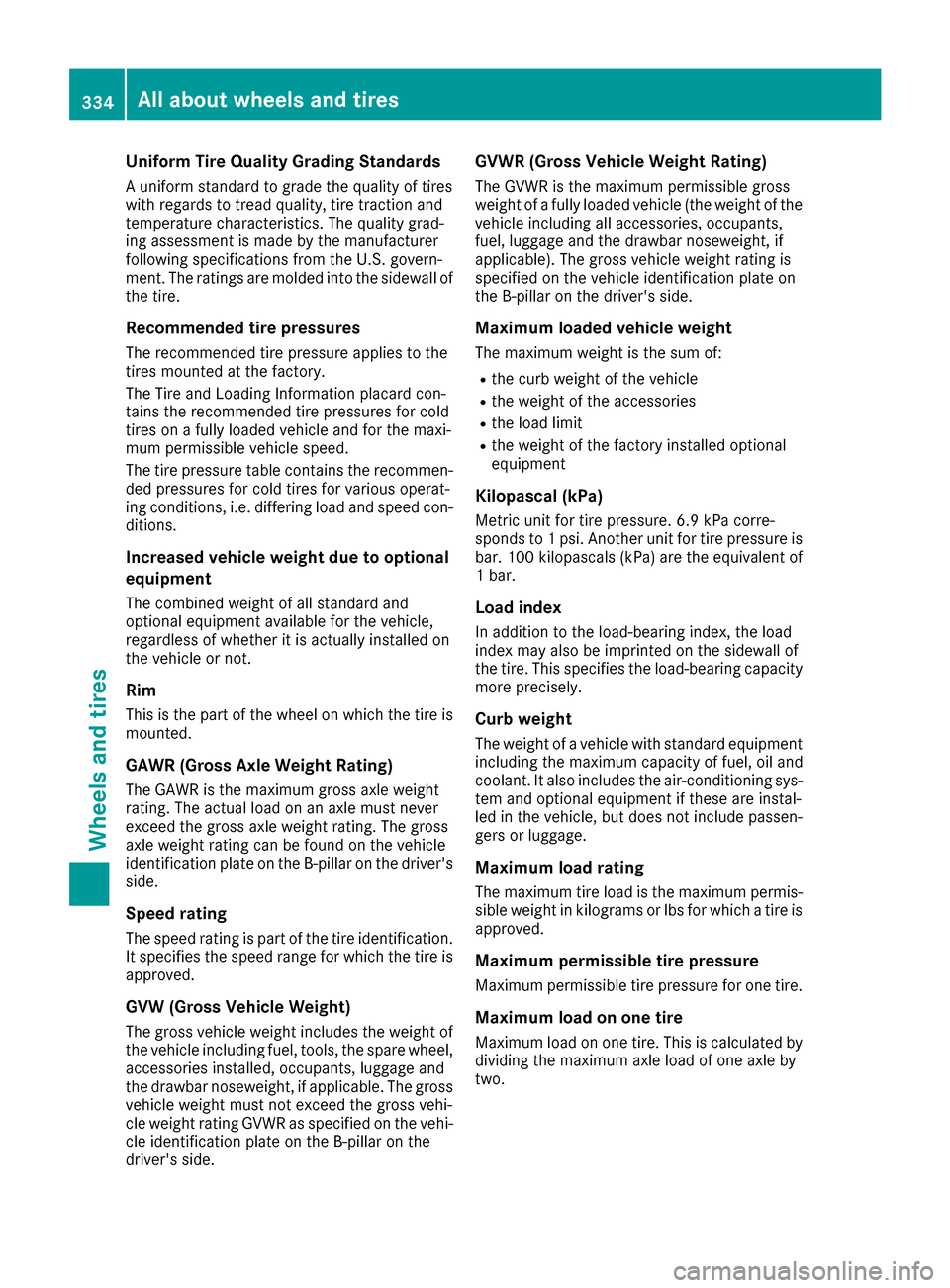
Uniform TireQualityG rading Standards
Aunifor mstandard to grade the quality of tires
with regards to tread quality, tire traction and
temperature characteristics. The quality grad-
ing assessmentism ade by the manufacturer
following specification sfrom the U.S .govern-
ment .The ratings are molded int othe sidewall of
the tire.
Recommended tir epressures
The recommended tire pressure applies to the
tires mounted at the factory.
The Tire and Loading Information placard con-
tains the recommended tire pressures for cold
tires on afully loaded vehicle and for the maxi-
mum permissible vehicle speed.
The tire pressure table contains the recommen-
ded pressures for cold tires for various operat-
ing conditions, i.e. differingl oad and speed con-
ditions.
Increased vehicle weight due to optional
equipment
The combined weight of all standard and
optional equipment available for the vehicle,
regardless of whether it is actually installed on
the vehicle or not.
Rim
This is the part of the wheel on which the tire is
mounted.
GAWR (Gross Axle Weight Rating)
The GAWR is the maximum gross axle weight
rating. The actual load on an axle must never
exceed the gross axle weight rating. The gross
axle weight ratin gcan be found on the vehicle
identification plate on the B-pillar on the driver's
side.
Speed rating
The speed ratin gispart of the tire identification.
It specifies the speed range for which the tire is
approved.
GVW (Gross Vehicle Weight)
The gross vehicle weight includes the weight of
the vehicle includin gfuel, tools, the spare wheel,
accessories installed, occupants, luggage and
the drawbar noseweight ,ifapplicable. The gross
vehicle weight must not exceed the gross vehi-
cle weight ratin gGVWR as specified on the vehi-
cle identification plate on the B-pillar on the
driver'ss ide.
GVWR(Gross Vehicle Weight Rating)
The GVWR is the maximum permissible gross
weight of afully loaded vehicle (the weight of the
vehicle includin gall accessories, occupants,
fuel, luggage and the drawbar n
oseweight
,if
applicable). The gross vehicle weight ratin gis
specified on the vehicle identification plate on
the B-pillar on the driver'ss ide.
Maximum loaded vehicle weight
The maximum weight is the sum of:
Rthe curb weight of the vehicle
Rthe weight of the accessories
Rthe load limit
Rthe weight of the factory installed optional
equipment
Kilopascal (kPa)
Metric unit for tire pressure. 6.9 kPa corre-
sponds to1psi. Another unit for tire pressure is
bar. 100 kilopascals (kPa) are the equivalent of
1b ar.
Load index
In addition to the load-bearin gindex ,the load
index may also be imprinted on the sidewall of
the tire. This specifies the load-bearin gcapacity
more precisely.
Curb weight
The weight of avehicle with standard equipment
includin gthe maximum capacityoff uel, oil and
coolant .Italso includes the air-conditionin gsys-
tem and optional equipment if these are instal-
led in the vehicle, but does not include passen-
gers or luggage.
Maximum load rating
The maximum tire load is the maximum permis-
sible weight in kilogram sorlbs for which atire is
approved.
Maximum permissible tir epressure
Maximum permissible tire pressure for one tire.
Maximum load on one tire
Maximum load on one tire. This is calculated by
dividing the maximum axle load of one axle by
two.
334All about wheels and tires
Wheels and tires
Page 337 of 354
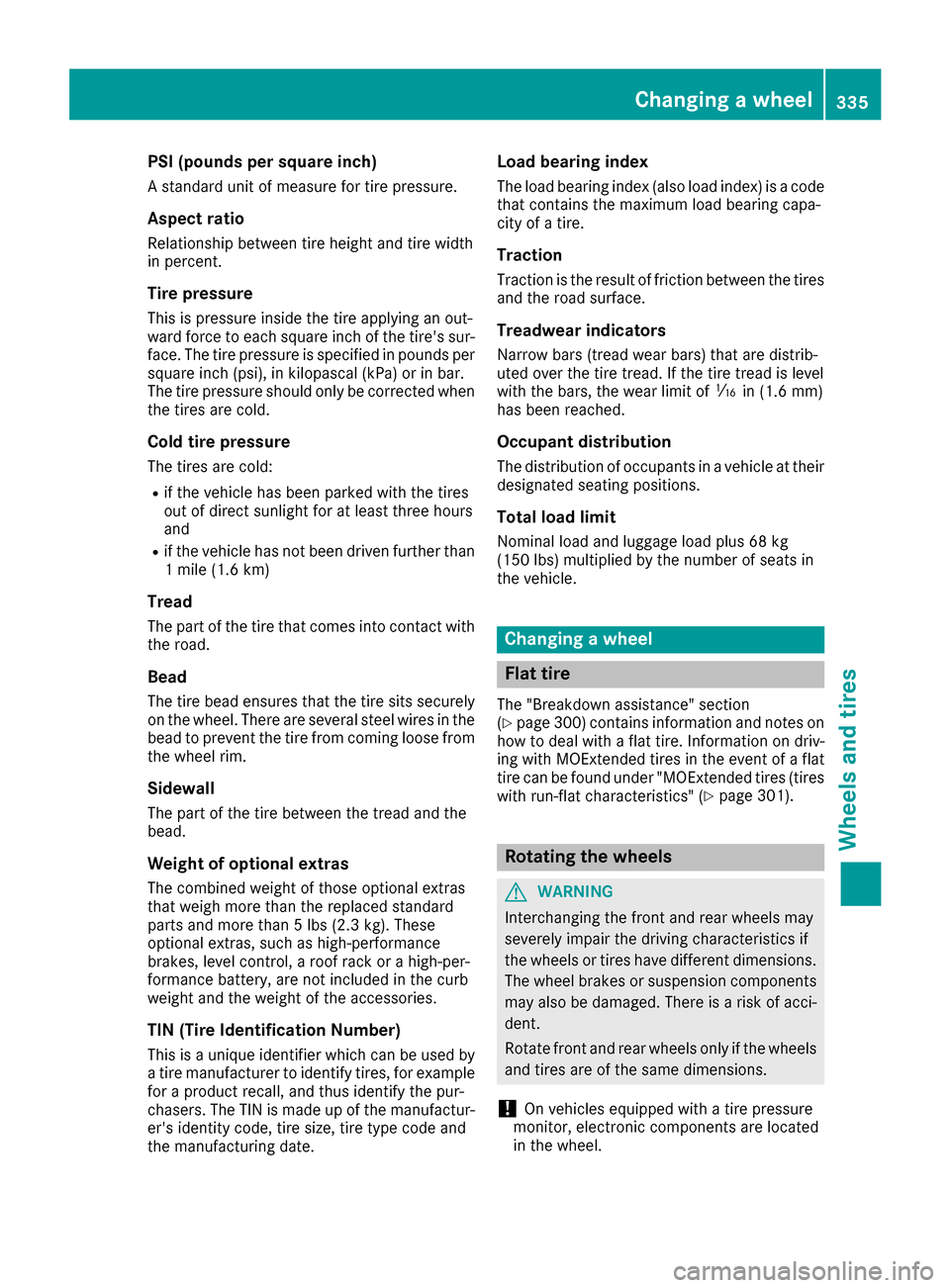
PSI (pounds per squareinch)
Astandard unit of measure for tire pressure.
Aspect ratio
Relationship between tire height and tire width
in percent.
Tire pressure
This is pressure inside the tire applying an out-
ward force to each square inch of the tire's sur-
face. The tire pressure is specified in pounds per
square inch (psi), in kilopascal (kPa) or in bar.
The tire pressure should only be corrected when
the tires are cold.
Cold tire pressure
The tires are cold:
Rif the vehicle has been parked with the tires
out of direct sunlight for at least three hours
and
Rif the vehicle has not been driven further than
1m ile (1.6 km)
Tread
The part of the tire that comes into contact with
the road.
Bead
The tire bead ensures that the tire sits securely
on the wheel. There are several steel wires in the
bead to prevent the tire from coming loose from
the wheel rim.
Sidewall
The part of the tire between the tread and the
bead.
Weight of optional extras
The combined weight of those optional extras
that weigh more than the replaced standard
parts and more than 5lbs (2.3 kg). These
optional extras, such as high-performance
brakes, level control, aroof rack or ahigh-per-
formanceb attery, are not included in the curb
weight and the weight of the accessories.
TIN (Tire Identification Number)
This is aunique identifier which can be used by
at ire manufacturer to identify tires, for example
for aproduct recall, and thus identify the pur-
chasers. The TIN is made up of the manufactur-
er's identity code, tire size, tire type code and
the manufacturing date.
Load bearing index
The load bearing index (also load index) is acode
that contains the maximum load bearing capa-
city of atire.
Traction
Traction is the result of friction between the tires
and the road surface.
Treadwear indicators
Narrow bars (tread wear bars) that are distrib-
uted over the tire tread. If the tire tread is level
with the bars, the wear limit of áin (1.6 mm)
has been reached.
Occupant distribution
The distribution of occupants in avehicle at their
designated seating positions.
Total load limit
Nominal load and luggage load plus 68 kg
(15 0lbs)m ultiplied by the number of seats in
the vehicle.
Changing awheel
Flat tire
The "Breakdown assistance" section
(Ypage 300) contains information and notes on
how to deal with aflat tire. Information on driv-
ing with MOExtended tires in the event of aflat
tire can be found under "MOExtended tires (tires
with run-flat characteristics" (
Ypage 301).
Rotating the wheels
GWARNING
Interchanging the front and rear wheels may
severely impair the driving characteristics if
the wheels or tires have different dimensions. The wheel brakes or suspension components
may also be damaged. There is arisk of acci-
dent.
Rotate front and rear wheels only if the wheels and tires are of the same dimensions.
!On vehicles equippedw ithatire pressure
monitor ,electronic components are located
in the wheel.
Changing awheel335
Wheels and tires
Z
Page 338 of 354
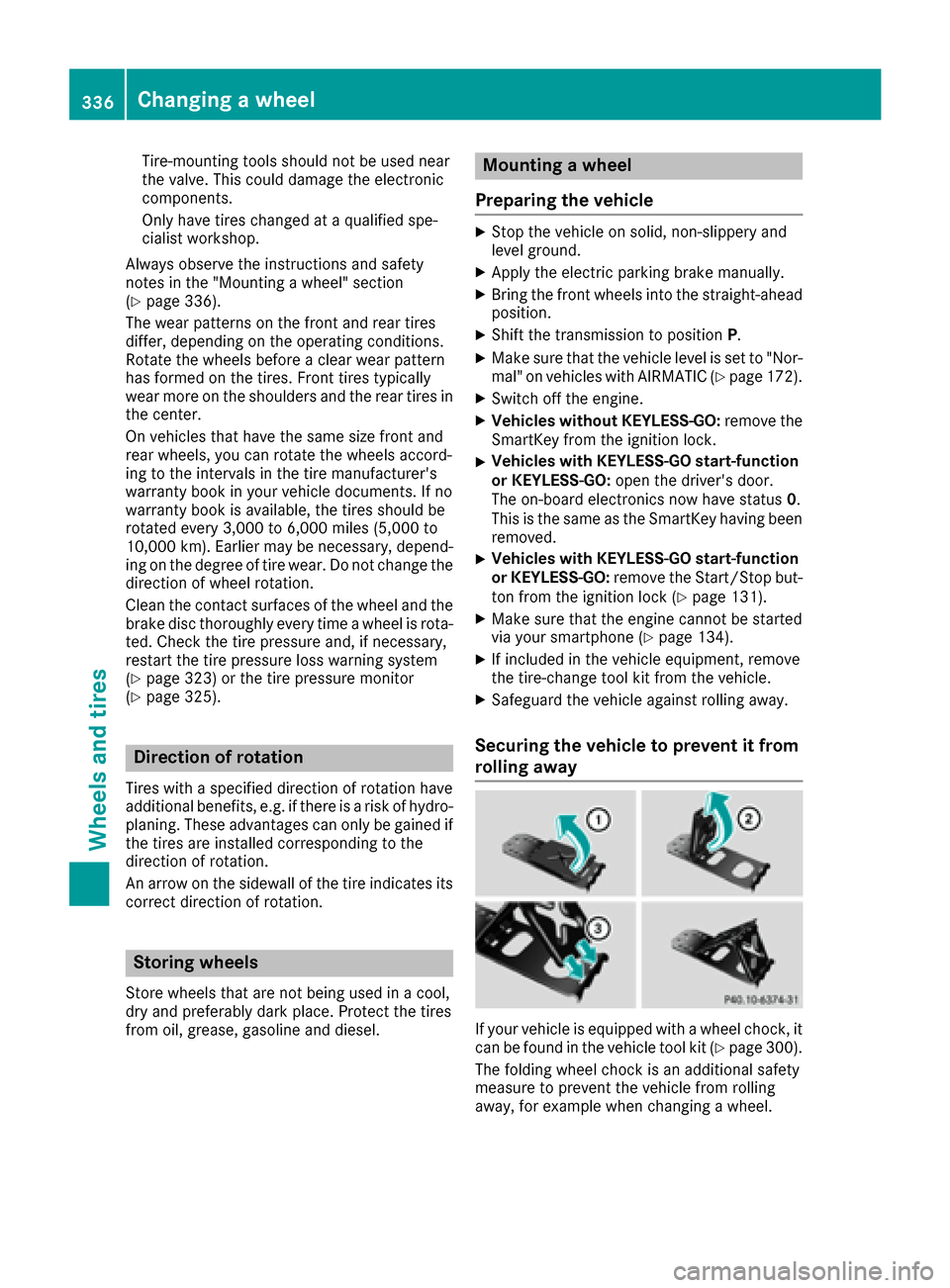
Tire-mounting tools should not be used near
the valve. This could damage the electronic
components.
Only have tires changed ataqualified spe-
cialist workshop.
Always observe the instructions and safety
notes in the "Mounting awheel" section
(
Ypage 336).
The wear pattern sonthe front and rear tires
differ, depending on the operating conditions.
Rotate the wheels before aclear wear pattern
has formed on the tires. Frontt ires typically
wear more on the shoulders and the rear tires in the center.
On vehicles that have the same size front and
rear wheels, you can rotatet he wheels accord-
ing to the intervals in the tire manufacturer's
warranty book in your vehicle documents. If no
warranty book is available, the tires should be
rotated every 3,000 to 6,000 miles (5,000 to
10,000k m).Earlier may be necessary, depend-
ing on the degree of tire wear. Do not change the
direction of wheel rotation.
Clean the contact surfaces of the wheel and the
brake disc thoroughly every time awheel is rota-
ted. Check the tire pressure and, if necessary,
restart the tire pressure loss warning system
(
Ypage 323) or the tire pressure monitor
(Ypage 325).
Direction of rotation
Tires with aspecified direction of rotation have
additional benefits ,e.g. if there is arisk of hydro-
planing. These advantages can only be gained if
the tires are installed corresponding to the
direction of rotation.
An arrow on the sidewall of the tire indicates its
correctd irection of rotation.
Storing wheels
Storewheels that are not being used in acool,
dry and preferably dark place. Protectt he tires
from oil, grease, gasoline and diesel.
Mounting awheel
Preparing the vehicle
XStop the vehicle on solid, non-slippery and
level ground.
XApply the electric parking brake manually.
XBring the front wheels into the straight-ahead position.
XShift the transmission to position P.
XMake sure that the vehicle level is set to "Nor-
mal" on vehicles with AIRMATIC(Ypage 172).
XSwitch off the engine.
XVehicles without KEYLESS-GO: remove the
SmartKey from the ignition lock.
XVehicles with KEYLESS-GO start-function
or KEYLESS-GO: open the driver's door.
The on-board electronics now have status 0.
This is the same as the SmartKey having been
removed.
XVehicles with KEYLESS-GO start-function
or KEYLESS-GO: remove the Start/Stop but-
ton from the ignition lock (
Ypage 131).
XMake sure that the engine cannot be started
via your smartphon e(Ypage 134).
XIf included in the vehicle equipment, remove
the tire-change tool kit from the vehicle.
XSafeguard the vehicle against rolling away.
Securing the vehicle to prevent it from
rolling away
If your vehicle is equipped with awheel chock,i t
can be found in the vehicle tool kit (Ypage 300).
The folding wheel chock is an additional safety
measure to prevent the vehicle from rolling
away,f or example when changing awheel.
336Changing awheel
Wheels and tires
Page 339 of 354

XFold both plates upwards:.
XFold outlower plate ;.
XGuide the lugs on the lower plate fully into the
openings in base plate =.
XPlace chocks or other suitabl eitems under
the front and rearoft he wheel that is diago-
nally opposite the wheel yo uwishtoc hange.
Raising the vehicle
GWARNING
If yo udon ot positio nthe jack correctly at the
appropriate jacking point of the vehicle, the
jack could tip over with the vehicle raised.
There is arisk of injury.
Only positio nthe jack at the appropriate jack-
ing point of the vehicle. The base of the jack
mus tbep ositioned vertically ,directly under
the jacking point of the vehicle.
!The jack is designe dexclusively for jacking
up the vehicle at the jacking points. Other-
wise, your vehicle could be damaged.
Observe the following whe nraising the vehi-
cle:
RTo raise the vehicle, only use the vehicle-spe-
cifi cjack that has bee ntested and approved
by Mercedes-Benz. If use dincorrectly ,the
jack could tip over with the vehicle raised.
RThe jack is designe donly to raise and hol dthe
vehicle for ashortt ime while awheel is being
changed. It mus tnot be use dfor performing
maintenance wor kunder the vehicle.
RAvoid changing the wheel on uphil land down-
hil lslopes.
RBeforer aising the vehicle, secure it from roll-
ing away by applying the parking brake and inserting wheel chocks. Do not disengage the
parking brake while the vehicle is raised.
RThe jack mus
tbep laced on afirm, fla tand
non-sli psurface .Onal oose surface ,alarge,
flat, load-bearing underlay mus tbeu sed. On a
slippery surface ,anon-sli punderlay mus tbe
used, e.g. rubber mats.
RDo not use wooden blocks or simila robjects
as ajack und erlay.Otherwise ,the jack will not
be able to achieve its load-bearing capacity
duetot he restricted height.
RMake sur ethat the distance between the
underside of the tires and the ground doe snot
excee d1.2 in (3 cm).
RNeve rplace your hand sand feet under the
raised vehicle.
RDo not li eunder the vehicle.
RDo not start the engine whe nthe vehicle is
raised.
RDo not ope norclosead oorort he trunk lid
whe nthe vehicle is raised.
RMake sur ethat no persons are present in the
vehicle whe nthe vehicle is raised.
Vehicles with alloy wheel sand hub caps: the
wheel bolts are covered by ahub cap .Befor eyou
can unscre wthe wheel bolts, yo umustremove
the hub cap .Two different variants can be instal-
led.
Vehicles with plasti chub cap:
XTo remove: turn the center cover of hub
cap :counter-clockwis eand remove.
XTo install: before installing, ensure that hub
cap :is in the ope nposition. To do this, turn
the center cover counter-clockwise.
XPositio nhub cap :and turn the center cover
clockwise until hub cap :engages physically
and audibly.
XMake sur ethat hub cap :is installed
securely.
Changing awheel337
Wheels and tires
Z
Page 340 of 354
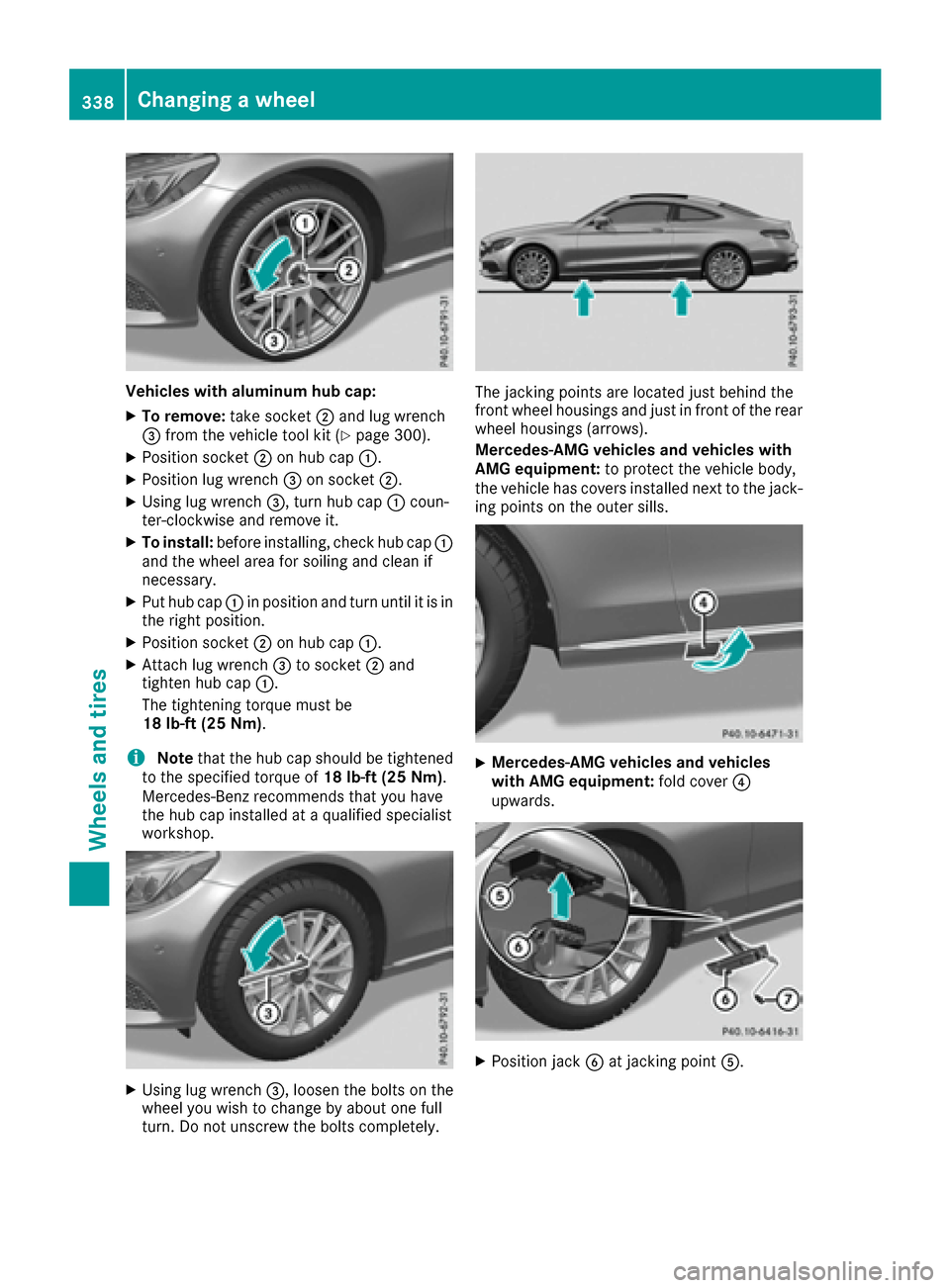
Vehicles with aluminum hub cap:
XTo remove:take socket;and lu gwrench
= from the vehicl etool kit (Ypage 300).
XPosition socket ;on hubc ap:.
XPosition lu gwrench =on socket ;.
XUsing lugwrench =,turn hubc ap: coun-
ter-clockwise and remove it.
XTo install: before installing, check hubc ap:
and the wheel are afor soiling and clean if
necessary.
XPuth ubcap :in position and turn unti litisin
the right position.
XPosition socket ;on hubc ap:.
XAttach lu gwrench =to socket ;and
tighten hubc ap:.
The tightening torque mus tbe
18 lb-ft (2 5Nm).
iNote that the hubc ap shouldbetightened
to the specified torque of 18 lb-ft (25 Nm).
Mercedes-Benz recommend sthat yo uhave
the hubc ap installed at aquali fied specialist
workshop.
XUsing lu gwrench =,loosent he bolts on the
wheel yo uwishtoc hange by abouto ne full
turn. Do not unscrew the bolts completely.
The jacking points are locate djust behind the
front wheel housing sand jus tinfront of the rear
wheel housing s(arrows).
Mercedes-AMG vehicle sand vehicle swith
AMG equipment: to protect the vehicl ebody,
the vehicl ehascovers installed next to the jack-
ing points on the outer sills.
XMercedes-AMG vehicle sand vehicles
with AMG equipment: foldc over ?
upwards.
XPosition jack Bat jacking point A.
338Changingawheel
Wheelsand tires